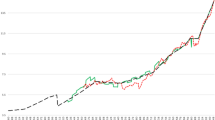Summary
An attempt has been made to estimate a putty-clay vintage model for the Netherlands in order to test the assumption, usually made in the Dutch vintage model discussion, of complementarity ex ante. The estimation led to the following conclusions: an elasticity of substitution of about 0.32, a planning period of 13 years and apart from the 1950s the existence of embodied labour-augmenting technical progress only. The model outcomes lead to the conclusion of capital shortage being the ruling phenomenon in the postwar period with only some short periods in the 1950s and the late-1960s of capital abundance. Since the late-1970s employment growth is not only depressed by too slow a growth of capacity demand for labour but also by the increasing underutilization of productive capacity.
Similar content being viewed by others
Author information
Authors and Affiliations
Additional information
Part of this research has been made possible by a grant of the Netherlands Organization for the Advancement of Pure Research (ZWO) and the National Programme of Labour Market Research (NPAO). The authors are indebted to Professor Th. van de Klundert for valuable comments.
Rights and permissions
About this article
Cite this article
Kuipers, S.K., van Zon, A.H. Output and employment growth in the Netherlands in the postwar period: A putty-clay approach. De Economist 130, 38–70 (1982). https://doi.org/10.1007/BF02371709
Issue Date:
DOI: https://doi.org/10.1007/BF02371709




